Diecast Diaries
17 May 2019
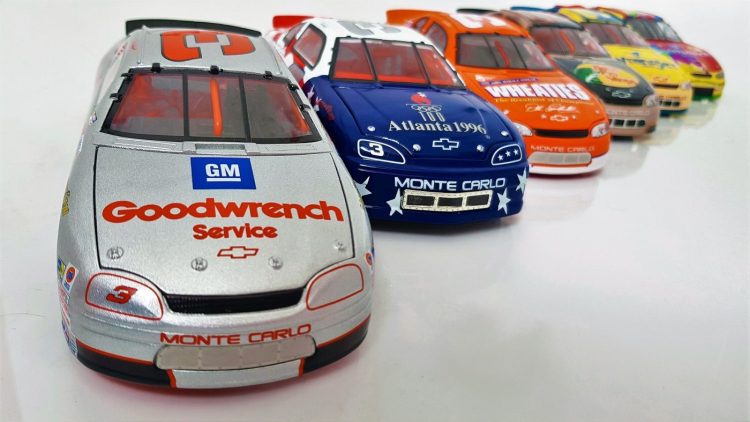
Action 1:24 – Credit: Dominik Wilde
Nowadays you rarely see drivers in NASCAR turning up with the same paint scheme week-in, week-out, but in the 1990s it was relatively rare for drivers to roll-out one-off paint schemes.
The trend arguably started with Dale Earnhardt in the 1995 All Star race, then known as ‘The Winston Select’. Since 1988 Earnhardt famously ran the all black #3 Chevrolet, but for the 1995 showcase non-championship race, he shocked the NASCAR community and began a trend that would grow to become the norm over the following two decades.
Ahead of this weekend’s All Star race, here’s a look back at all of Dale Earnhardt’s one-off paint schemes that he ran in the race.
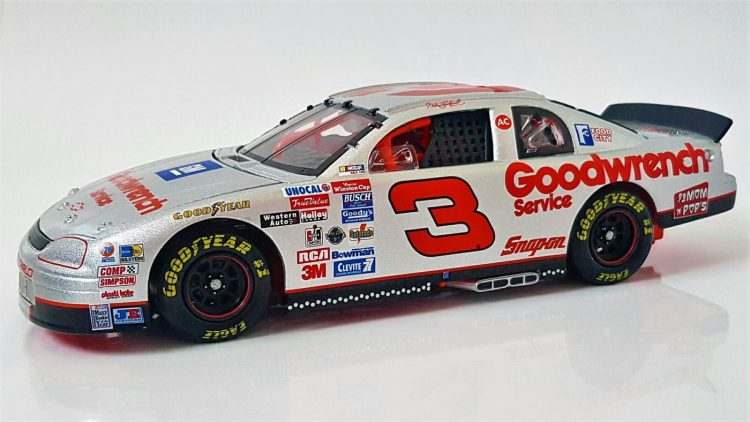
Action 1:24 – Credit: Dominik Wilde
To commemorate the 25th anniversary of R. J. Reynolds tobacco company, which owned series sponsor Winston, Earnhardt ran a silver car in the 1995 Winston Select. Ahead of the race the car was shrouded in secrecy, with even team members not knowing about the car until it rolled off the team’s truck when it arrived at the track.
“I think this car was the last secret that anybody ever had in NASCAR,” Earnhardt’s gas man and Richard Childress Racing museum curator ‘Chocolate’ Myers said in 2018. “It caught everybody by surprise, it actually caught all of us by surprise because we didn’t know about it either.”
Team boss Richard Childress gave the team the night off before the car headed to the track, and the car was painted that night, with only a select few aware of the colour change.
In the race, Earnhardt collided with Darrell Waltrip, handing the win to Jeff Gordon. The famous car later made the trip across the pod, appearing at the Goodwood Festival of Speed in 2018.

Action 1:24 – Credit: Dominik Wilde
A year later Earnhardt drove another striking one-off in The Winston, this time marking the Olympic Games which were taking place in Atlanta that year.
While the silver car of ’95 could be said to start the trend of one-off paint schemes, the 1996 car was also a trendsetter, with Ken Schrader, Rusty Wallace, and Terry Labonte all running Olympic-themed cars after Earnhardt’s striking Stars and Stripes car made its appearance.
Earnhardt won the second part of the race, collecting a $50,000 cheque in the process, and was in contention for the overall win before a late move from Michael Waltrip relegated him back to third at the chequered flag.
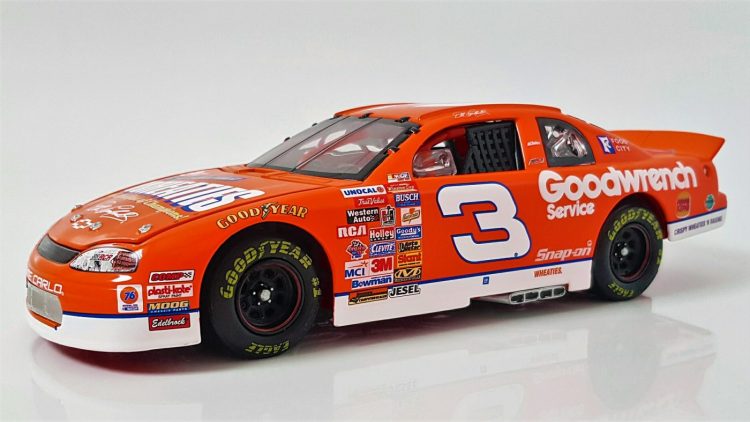
Action 1:24 – Credit: Dominik Wilde
If the first two cars on this list weren’t striking enough, the 1997 Winston one-off certainly was. The bright orange car, brought about as a result of a tie-in with Wheaties cereal, definitely stood out.
It was not only the first time a racing driver had featured in a tie-up with Wheaties, but it was the first time a sponsor had come in for a one-off deal; and colours aside, the car was also a favourite of Earnhardt’s.
“After the race, Dale sat down and said ‘man, leave this car just like it is. Leave the orange on it. I don’t want it painted. Can we please come back next week and run this car again?’ Of course, we couldn’t. We had to come back and paint the car black,” RCR’s Jerry Haley said of the car earlier this year. “He really loved this car. This is one of his favourite cars of all time.”
The car – which was raced at Texas before its Winston appearance – also raced again at Charlotte in the 600-mile race a week later, before competing at Fontana, Indianapolis, Charlotte again, and Atlanta in 1997, and Pocono twice, Indianapolis, and Texas in 1998 before it was restored to its orange Wheaties paint scheme.
It was also the subject of a controversy earlier this year when a replica show car resembling it was auctioned off, with the auction house listing it as the real deal.
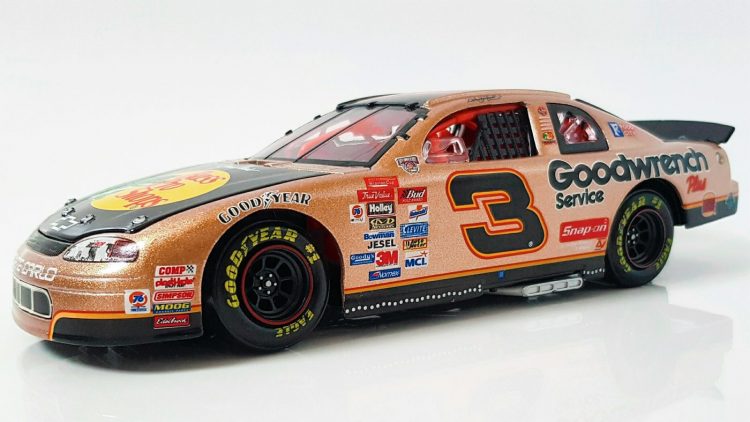
Action 1:24 – Credit: Dominik Wilde
In 1998 Earnhardt brought the bling with a gold car backed by Bass Pro Shops. The outdoor retailer joined Earnhardt’s team as an associate sponsor that year and took top billing for the exhibition race at Charlotte.
The partnership between Earnhardt and Bass Pro Shops was fitting – at the time Earnhardt said he would probably do “something involved with the outdoors” if he wasn’t racing cars.
“When I get away from the race track, I usually head to the woods or the nearest lake,” he said. “It’s my way to relax and get away from the phones.”
Sadly the gold car didn’t bring a gold medal position. After a pit lane mishap in qualifying Earnhardt started from the rear of the field and was involved in a wreck early on in the race.

Action 1:24 – Credit: Dominik Wilde
The car that Earnhardt ran in 1999 was less of a one-off special and more of a throwback. That year’s car for The Winston brought back Earnhardt’s long-time sponsor Wrangler Jeans and the company’s iconic yellow and blue paint scheme after more than a decade away. Earnhardt spent seven years driving the Wrangler car, winning two of his seven NASCAR Cup titles with the brand’s backing in the ’80s.
Despite Wrangler’s return, GM Goodwrench, which took over as Earnhardt’s primary sponsor in 1988, remained prominent on the cawr, making it very much a greatest hits album of Earnhardt’s career.
“This paint scheme is pretty special,”Earnhardt said. “It represents the two major sponsors I have had throughout my racing career. We were fortunate to represent both GM Goodwrench Service Plus and Wrangler Jeans as champions, it will be great to get them into Victory Lane again.”
Alas, Earnhardt couldn’t return to victory lane in the race, making do with fourth place and a cheque for $30,000.
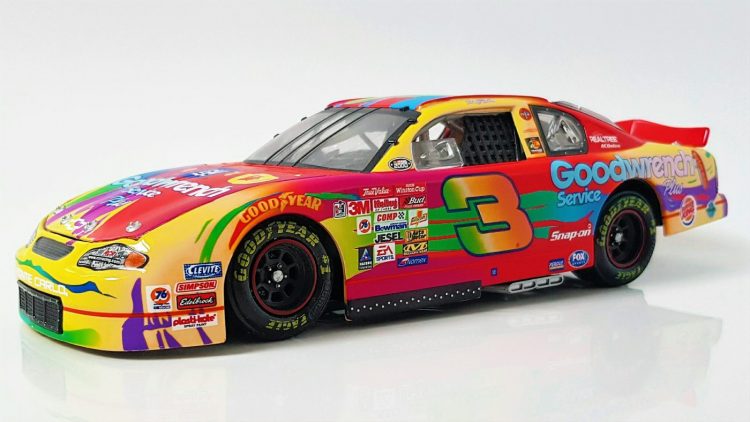
Action 1:24 – Credit: Dominik Wilde
Earnhardt ran the Winston for the final time in 2000, competing with arguably his most outlandish paint scheme, which had been designed by renowned artist Peter Max. The eye-popping yellow and pink livery was a far cry from the ‘Intimidator’ black we’d become used to.
“Some love it, some hate it,” said Chocolate Myers earlier this week. “I don’t think the guy that was driving the car that day (Earnhardt) was really fond of it.”
“This is the tough guy, this is Dale Earnhardt, this is the black car, and for him to get out of that car, I’m not so sure what they had to do to convince him,” Myers added. “I will say this – Dale had a lot of clout because he was Dale. They could ask him to do something and he may say I’m not going to do that, most of the time he did.”
Maybe Earnhardt had a softer side after all. Not too soft though, the rumoured matching driver soon never made an appearance.
Despite being involved in a wreck in the second part of the race and later being passed by his son, Earnhardt brought the ‘art car’ home in third.
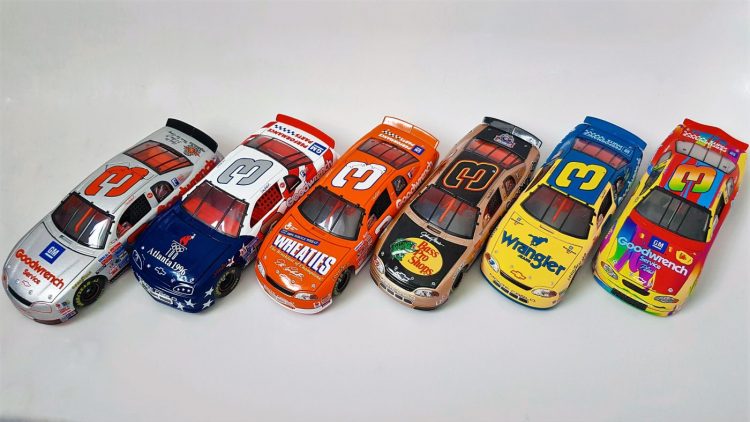
Action 1:24 – Credit: Dominik Wilde
Diecast Diaries is a regular series where I tell the real-world stories of the cars in my personal collection of diecast racing cars.